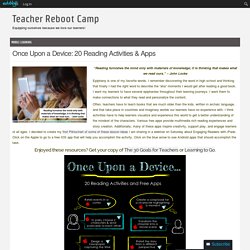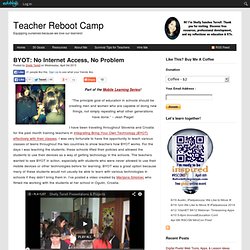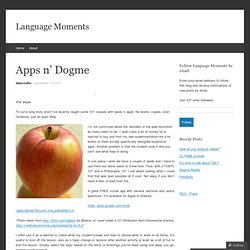Zoom
Trash

Teaching with Apps. Eltchat [licensed for non-commercial use only] / How do you use mobile devices in the classroom Tips, apps, best practices. ELT Chat Summary - 30th April How do you use mobile devices in the classroom?
![eltchat [licensed for non-commercial use only] / How do you use mobile devices in the classroom Tips, apps, best practices](http://cdn.pearltrees.com/s/pic/th/commercial-classroom-practices-49473100)
Tips, apps & best practices Introduction This was the initial question for the evening's discussion, although there was some debate about the definition of mobile devices. Some people suggested digital cameras, laptops, tablets – there are also dictophones and digital video cameras. Archive I wanted to take a closer look at the iPad Evaluation I previously blogged about in Evaluating Apps with Transformative Use in Mind. The section of Content and Components deserved a closer look and explanation. You can download the PDF file of the iPad App Evaluation for the Classroom with the following sections of evaluation included: ConsiderationsContent & ComponentsLogisticsFluencySubstitution vs Transformation Model (based on SAMR model of Ruben Puentedura and Alan November‘s work)Evidence of Learning (based on conversation with Stephen Wilmarth)
Free Apps to Support Vocabulary Acquisition by ELLs. One of my favorite aspects of integrating technology into instruction is the availability of resources to support students with different learning needs.

Students who are struggling can benefit from the excitement and engagement offered by a tool like the iPad. Teachers of English-Language Learners (ELLs) can use technology to promote growth in their students. Developing a strong vocabulary is an important area of focus for ELLs who are building their reading comprehension. Educators use a variety of strategies to grow readers in their classroom, and there are many free iPad apps that support vocabulary acquisition. Kids' Vocab by MindSnacks. Non-Flash Things for ESL/EFL Students (iPad, iPhone, etc.) American TESOL Institute's Mobile Website. Mobile English. By Nicky Hockly and Gavin Dudeney Technical wizards Nicky Hockly and Gavin Dudeney present a series of lesson plans on using mobile phones in class, suitable for any device from the most basic phone to the latest smartphone.

M that learning! Mobile Learning Lesson Plans. Learning to Go! Learning to Go is a collection of lesson plans and tips for teachers wishing to incorporate mobile devices, phones or BYOT (Bring Your Own Technology) into their teaching.

Written by the unstoppable Shelly Sanchez, this promises to be a very practical and useful guide for teachers interested in edtech. But perhaps most interesting of all is the design of the book. There are no page numbers, and the journey through it might not be a linear one. Shelly has really taken advantage of the digital medium to experiment with book navigation and design. In her own words: I wanted to design an ebook that would encourage readers to explore. Please download the sample labs design to get a taste. Once Upon a Device: 20 Reading Activities & Apps. “Reading furnishes the mind only with materials of knowledge; it is thinking that makes what we read ours.” – John Locke Epiphany is one of my favorite words.

I remember discovering the word in high school and thinking that finally I had the right word to describe the “aha” moments I would get after reading a good book. I want my learners to have several epiphanies throughout their learning journeys. BYOT: No Internet Access, No Problem. Posted by Shelly Terrell on Wednesday, April 3rd 2013 Part of the Mobile Learning Series!

“The principle goal of education in schools should be creating men and women who are capable of doing new things, not simply repeating what other generations have done.” ~ Jean Piaget I have been traveling throughout Slovenia and Croatia for the past month training teachers in integrating Bring Your Own Technology (BYOT) effectively with their classes. EFL Through iPads. ELL to Go. ELL | Feature ELL to Go Two schools transform their ELL programs by giving students around-the-clock access to some of the latest mobile devices.

By Jennifer Demski05/02/11 The typical student at the Newcomer Center, an alternative school in Township High School District 214 in Arlington Heights, IL, is a recent immigrant with little or no English skills. The school is a temporary stopover for these students--they stay at the center for about a year, building up their English-language skills, and are then transferred to an ESL program at their home school in the district. The students at the center emigrated from countries around the world, and up until about a year ago, if you walked into the school's cafeteria during lunch, you'd see them separated into cliques or pairs based on their native tongue, chatting in the language they're most comfortable with rather than practicing the language they're trying to learn.
Lesson Plans. There is a lot of evidence to prove that sustained silent reading is exceedingly beneficial both inside and outside the classroom and a key advantage of mobile devices is the ease with which students can have access to rich reading resources.

Additionally, it is also possible to follow the written word on the page, whilst listening to an oral rendition of the text. This is particularly important to students whose mother tongue is written in a script that is not the Roman Alphabet and as in the case of Arabic, does follow the same spelling rules. Vowels are often not represented in written Arabic,: and thus students forget to incorporate them into their written English. Our institution subscribes to the Oxford Bookworms Series of Graded Readers for EFL students. Mobile learning. Well like a lot of people I’ve bought an iPad over the summer and I’ve been having my first taste of shopping for apps to extend the capabilities of the iPad. I’ve also been having a look at how some of these can be used for language learning, so I thought I would share with you a little bit of information about the first few apps I’ve tried. ForvoFor those of you who don’t know Forvo, it’s a marvelous pronunciation dictionary site which is collecting together audio examples of of the pronunciation of different words from languages and speakers all round the world.
The app works as a simple pronunciation dictionary which you can carry with you in class and whenever a new word comes up, you can get an example pronunciation form it. For many of the more common words in English you can get multiple examples from different speaker (male, female, UK, US, Australian etc.) It isn’t free, but it’s pretty cheap and you can download it from: Flip Board: a video showing how it works: Related links. Reflections on eLearning and teaching Drama, English/ESL and the Humanities!
Mobile Learning. Today we had the opportunity to present at the Discovery Education Day of Discovery Conference. We explored techniques for building a mobile learning environment and ways to use digital media in creating content on the iPad. It was exciting to demonstrate how digital media and web 2.0 tools remove boundaries and promote academic achievement for ELLs. mLearning Lesson Plans. List. Mlearning. Teaching with mobile devices: FAQs [part 1] Apr 14th, 2014 Tweet There is a good reason for my 3 month blogging hiatus. Since January, work has taken me to Chile for 2 weeks, Egypt for a week, India for 3 weeks, and Moscow for a week.
And then the TESOL US conference in Portland followed immediately by the IATEFL conference in Harrogate, UK – another […] Papers on mobile assisted language learning (MALL) Nov 25th, 2013. Mobile ESL. Lessonstream.org by Jamie Keddie. ESOL Courses - Free English Lessons Online. Language Moments. Phil Wade To cut a long story short I’ve recently taught some 121 classes with ipads n’ apps.

No books, copies, even handouts, just an ipad. Now, I’m not convinced about the ‘wonders of the ipad revolution’ as many seem to be. 1 ipad costs a lot of money for a teacher to buy and from my own experimentation not a lot works on them except specifically designed expensive apps. Another problem is that the student uses it and you can’t see what they’re doing. Mobile learning. With the growth in interest in mobile and handheld learning, I thought I’d investigate one of the many new Web 2.0 type start ups that are offering free (at the moment at least) services for setting up websites and web based communities to be accessed on mobile phones and other mobile devices.
The one I’ve started with is a service called Winksite. On the home page of their website the company claims that, “Winksite makes it easy to publish mobile websites and communities that can be viewed worldwide on any phone.” So I thought I would try to set up my own site as an extension of this blog.What’s good about itI was actually quite impressed at just how easy it is and at the number of features on offer.
Once you have registered, Winksite offers users the opportunity to set up as many as 5 websites for mobile devices. What's Your Ideal iPad Lesson?